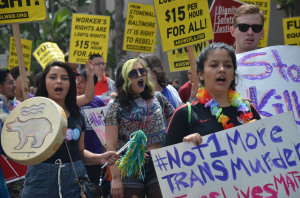
Originally published in Liberation Newspaper, June 2015
On June 6, 2013, in the Bed-Stuy neighborhood of Brooklyn, three gay men were walking home when they were confronted by New York Police Department officers from the 79th precinct. Falsely accusing the men of urinating in public, the cops screamed a homophobic slur at them. One was shoved to the ground and pepper sprayed. The incident was captured on video.
The current wave of resistance against racist police brutality has, as has historically been the case of the struggle for Black liberation, energized movements by all oppressed people. It has helped bring to light the related phenomena of state repression against immigrants, the LGBTQ community, and women of oppressed backgrounds. Many #BlackLivesMatter leaders and organizers across the country are themselves LGBTQ and women, and they have powerfully expressed that all these struggles are deeply connected and must be united.
Two forms of state violence
Much of the violence experienced by the LGBTQ community is the result of direct attacks by the cops. The thuggish queer-bashing culture of the cops goes hand-in-hand with a culture of neglect when it comes to pursuing perpetrators of anti-LGBTQ hate crimes.
This culture of impunity is not just about individual officers or detectives looking the other way when LGBTQ people are assaulted and murdered. It is reflected in the government bureaucracy itself, which does not even attempt to accurately track hate crimes against LGBTQ people. Not coincidentally, there are no government statistics on incidents of police brutality.
An independent report published last year by the National Coalition of Anti-Violence Programs, which deals with data from 2013, documented over 2,000 cases of anti-LGBTQ violence. This includes 18 people who were murdered. Ninety percent of these victims were Black or Latino and 72 percent were transgender women.
Instead of providing assistance to survivors of hate crimes, the police often times perpetrate further violence. The same study found that almost 20 percent of those who reported an incident to police were themselves arrested! It should come as no surprise that the majority of LGBTQ people who are attacked by bigots do not even bother going to the police—it is often futile at best and dangerous at worst.
Many individual police officers are themselves bigots. But sensitivity training and other meager reforms do not address the root of the brutality facing LGBTQ people and all other oppressed sectors of society. The role of the police is to act as the front-line defenders of this system, punishing with overwhelming force any resistance, disobedience or challenge to the existing order. The order that the police protect and serve is based on capitalist inequality, racism and patriarchy.
That is why whenever workers rise up, whenever oppressed communities stir, and whenever women and LGBTQ people challenge their subordinate status, they can expect to see the police standing against them. As a new movement explodes in righteous anger against racism and state violence, it is giving voice to oppressed people from all walks of life, who desire not just reform, but real power.





